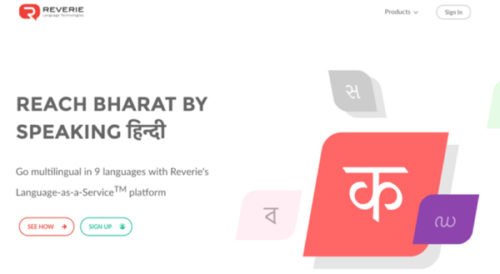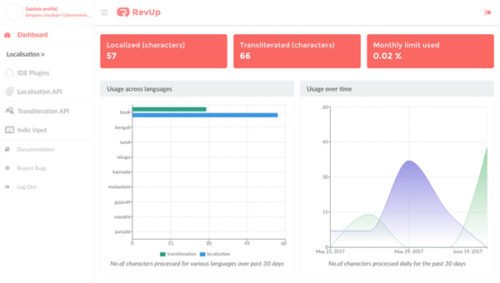
Internet and mobile technologies have revolutionsed our day to day lives. We have adopted these from the western English speaking world, whereby, the majority of content available on these platforms is available in English. India being a diverse country, where more than 100 languages are spoken, apart from the official 22 languages, the availability of content in the local languages becomes of critical importance. Language becomes a critical aspect of product penetration for brands, therefore developing technologies to help make content in local languages is the need of the hour. Reverie Language Technologies, is one such company at the forefront of these initiatives, and spoke to Team Estrade in an exclusive interview on this topic. Following are the excerpts of this interview with Vivekanand Pani, Co-Founder, Reverie Language Technologies.
Team Estrade: Tell us about Reverie Language Technologies? How is Reverie supporting localization?
Reverie’s vision is to promote Language Equality On The InternetTM. Founded in 2009 by Arvind Pani, Vivek Pani and S.K Mohanty, it is led by a strong R&D technology team that builds technologies to bridge the language divide in the digital world. Reverie works with OEM & chipset manufacturers, enterprises (Consumer Internet) and the developer community. Its platform provides localisation services such as local-language translation, transliteration, device input, and search through a set of APIs. The platform integrates with business infrastructure (websites and apps) to enable end users to consume digital content in their preferred language in multiple languages, real-time. Reverie serves the consumer Internet space (online retail, e-commerce marketplaces, travel, media & entertainment), banks and financial services, e-governance, across millions of devices. Reverie aims to enlarge the business vision of organizations beyond the realms of India’s 10% English users. Reverie derives its strength from India’s vast user demographic – 1.3BN Indians speak from amongst the 22 officially recognized languages and 720 dialects. The dialect spoken in India changes every 40 kms and 122 languages are each spoken by more than 10,000 people.
Reverie is supporting Localisation through:-
- Content conversion– Our language solutions enable applications to localize their content smartly. Intelligent localization transforms content based on the context around the strings or words. Intelligent localization translates/transliterates content contextually on the basis of the specified strings or words.
There are multiple ways of converting texts from one language to the other. First being a fuzzy pattern recognition training set for a learning system, which entirely depends upon the volume and quality of data ingested. Another approach involves in-depth analysis of different languages and maintaining their underlying rules and then mapping those rules for conversion. This acts like a rule based conversion template where the rule mappings keep on improving with data.
Reverie’s approach implements the best of both the worlds so that the model maintains an acceptable accuracy even thoughthe data usage grows with time.
- Content discovery– We also serve multilingual search for local language users to be able to discover content.
- User generated content– Is driven primarily through multilingual input via our Indic Keyboard Swalekh Flip where one can type in all 22 official languages of India.
Reverie’s language solutions to the above solutions are made available in form of APIs which can be consumed in any platform, be it Android, Web, iOS etc., to covert the application content on-the-fly.
Team Estrade: What is the size of the market that Reverie is currently competing in, both in India and the world?
The size of the overall global language industry in 2016 is estimated at $40 Billion (USD), with estimates of up to $45 Billion by 2020. The size of the language technology industry is estimated at $32.3 Billion.
Businesses on the Indian internet are sitting on a $30 Billion opportunity according to our estimates.
“most of the Internet & mobile savvy users in India had the luxury of learning how to use computers, the mobile phone over nearly a decade.”
Team Estrade: What is your go to market strategy? For each industry vertical.
Enterprise and SMB businesses – help businesses with specific initiatives where localisation plays a key role in increasing their reach or adds value in their digitization efforts for engagement with end customers
OEM/OEM/Mobile/Device Manufacturers – localized language experience for end users including for first time mobile users. From the moment you switch on a device to when you decide to search for something on a browser – Reverie can cover the experience.
Government – drive localisation for citizen service initiatives by Central & State governments that ensure digital empowerment
Developers – we have built a Language-as-a-Service (LaaS™) platform – a delivery platform for connecting with our APIs and tools so that developers can think language first from the build cycle itself.
Team Estrade: More and more users are using the Indian language keyboards on their smart phones, yet the local content on these seems to be growing slowly, why is that? Is there a limit to the ability of local language content to monetize itself? Television, being visual-audio in nature, seems to have done this successfully.
One of the chief reasons for this is because no one taught us how to type in our own languages, which must be taught to children at a young age in the school/educative phase. English is a linear language and has only 26 characters. Indic characters are complex where ‘matras’ are added before, after, above or below a character. First time mobile users will face a long learning curve which is natural, given that most of the Internet & mobile savvy users in India had the luxury of learning how to use computers, the mobile phone over nearly a decade. It is incorrect to expect Indic language users to adapt to it less than the time we took! Also, those who are not literate in ANY language will gravitate towards voice based language technology first because of ease of use.
An important factor that cannot be overlooked in all the Indic content creation is that it is not as important to create Indic content on the Internet as it is to create accurate Indic content on the Internet. What that means is that going forward we need to ensure proper input or typing of Indic languages so that multilingual search results are accurate.
“Notable activism in this space is by private citizens for ensuring fast moving items/consumable goods provide labeling in local languages.”
Team Estrade: Is the eco system in India ripe for companies such as Reverie?
The effect of languages on the entire ecosystem in India will be felt in the next 2-3 years. We always knew that this was going to be a business which needs to build the right technology and processes and prepare for the tipping point. Meanwhile, as with any other industry, there are early adopters who will be ready when that tipping point arrives. And there are other supplementary companies who recognize this and are preparing for different localisation needs – Vernacular.ai, Google, DailyHunt are some of them.
Team Estrade: What do you feel is the future of Indian language content with the evolution of Big Data, Complex machines and AI technologies? Are these going to be a boon for Indian local language consumer?
They will converge to provide a complete language experience which is the ideal scenario, but keep in mind that widespread adoption from businesses and end users will take a while. As stated above, there will be some businesses who will be willing to lead by example and apply it to their customer touch points and improve it over time, just like it was done for English. A/B testing for local audiences is a must and no different from English. The ability to apply Big Data in Indic languages is data dependent. Anything that removes friction from the standpoint of an end consumer is a boon for the Indian local language consumer.
Team Estrade: Is India’s technology policy equipped to drive technology development in the direction of local languages? Shouldn’t this be like a technology infrastructure push by the Government? After all, most tech infrastructure in the US was supported by their government.
Yes, we need a comprehensive language policy for localisation in India. There are certain pockets where this is already happening and where the government is already involved. We were part of the committee on making display and input mandatory for Indian languages on devices (starting July 1, 2017) where the appropriate government, business and service provider representation was there. Other notable activism in this space is by private citizens for ensuring fast moving items/consumable goods provide labeling in local languages. We’re trying to do the same now in the space of financial inclusion.
Also, the government can lead efforts towards localisation, but it merits participation from businesses and service providers like us. Standards have to be set carefully post discussion with concerned parties.
Team Estrade: What is Reverie’s LaaS platform?
Image 1: Value proposition of Reverie’s LaaS™ platform

“Voice based products apart from continued focus on machine translation is the future of localisation.”
LaaS (Language as a Service™) platform was built to help developers build apps in local languages in parallel with English, if not first. The experience of helping previous businesses like Snapdeal, Ola, Hungama, Quikr, Practo, and our interaction with developers and product managers who wanted to go multilingual came in handy while designing our platform. Building a delivery platform for localisation to service this audience of technically savvy helped them ‘see’ how easy it was to localize and familiarize themselves with tools that they could easily apply during their build process. The platform offers tools that help developers and product managers make their app multilingual. Here are the tools Reverie provides:
Image 02: Reverie LaaS dashboard

“In the long term, we aim to provide an end to end language experience via technology”
Tools available on the LaaS™ platform for developers and product manager.
- Transliteration is the phonetic conversion from one script to another. It is useful when trying to show display proper nouns, such as addresses, names etc.
Example: For a cab aggregator, onboarding drivers with their preferred local language become easy if they are able to show the pickup address and the name of passenger in a language of their choice.
- Indic Input, this is an input plugin that offers developers easy integration of typing options on their web platform. Even though people want to communicate in the language of their choice, there are not many tools or web keyboards that allow users to create content in local languages easily. Indic Input was made with them in mind.
- (Beta) IDE Plugin, takes care of localizing the navigational content. It offers one click localization for menu items. Though in beta, it eases the effort of manually converting strings.xml files in multiple languages. This is a very popular tool amongst Android developers who build native Android apps.
- (Beta) Localization, as the name suggests converts content via translation based on specific domains such as ecommerce, banking etc. A word or a phrase can have different meanings based on which domain or context it is used in.
Team Estrade: Which product segment is the highest revenue earner for your company? What are some of the future local language products and/services envisaged by you?
OEM/OEM/Mobile/Device Manufacturers continue to see value in providing a better language experience for end users on their devices. Certain state governments are also actively looking at localisation for their citizen services. In the Consumer Internet space, we see most interest from the BFSI sector apart from ecommerce or supply chain initiatives, especially for rural India. Voice based products apart from continued focus on machine translation is the future of localisation.
What is the biggest challenge faced currently by your industry of operation?
- Breaking the myths and assumptions around localisation continues to be a challenge. Some of them include:
- Indian language users do not have purchasing power
- What works for English users will work for Indian language users
- Localisation in Indian languages is a growth hack
- Indian language needs no investment
- Customer lifecycle journey for Indian language users does not exist
Team Estrade: Who are your investors?
Qualcomm Ventures and Aspada Investments – both of whom take a long term approach to investing in sectors that result in high socio-economic impact.
Team Estrade: What is your vision for Reverie, in terms of,
- Near term future, over the rest of 2017:
To continue to establish business impact via localisation
To continue to drive evangelization for localisation
Participate in regulatory framework for mandating localisation
- Long term, over the next 4 years or so.
Provide an end to end language experience via technology.
“We need a comprehensive language policy for localization” – Reverie Language






